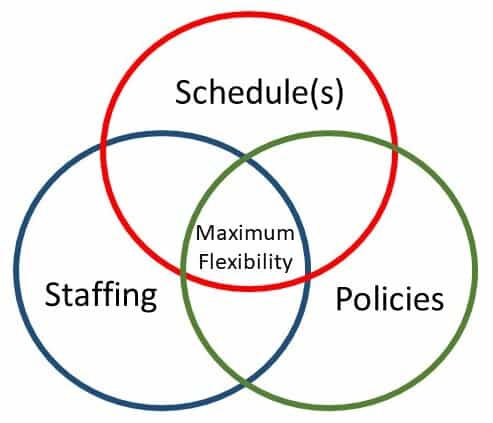During the pandemic, many companies have found that flexible scheduling ideas such as work-from-home, helped them to attract and retain valuable employees. A neat trick during a tight labor market if you can pull it off. However, for many companies with production lines on-site, work-from-home is not feasible. Does this mean flexible scheduling is not something they can offer? If so, they would be missing out on one of the major competitive advantages to attract a workforce.
Shift workers understand that their jobs don’t allow them to work from home. This doesn’t mean that they don’t place a high value on schedule flexibility. To them, schedule flexibility means that (1) they can get extra work when they want it but (2) can also count on having scheduled time off when they expect it.
For most 24/7 operations, being able to accommodate these two desires –overtime and predictable time off – is a function of three things: staffing, policies, and the schedule. The combination of all three of these will create the maximum schedule flexibility that you can offer to your workforce.
Staffing, under most circumstances, will dictate the total amount of overtime an operation will have. Is the overtime too much or too little? How can you tell and how can you make adjustments?
Policies, specifically overtime distribution policies, ensure that overtime gets to those that want it without forcing it on people that don’t. How do you know which policies fit both the needs of production and the needs of your workforce?
The schedule tells you when the straight time and overtime will occur and allows you to distribute your staffing and apply your policies in the most efficient manner possible. How do you establish the proper relationship between the shift schedule and the nature of the workload? Notice that the schedule tells you when the overtime occurs but not how much. The latter is a function of staffing.
The most important thing about the schedule is that if you have the right one, you can offer the “Holy Grail” of schedule flexibility – No Mandatory Overtime, the shift schedule feature most desired by the workforce. This way, if someone is at work, it is either a regularly scheduled workday or the person volunteered to come in and work overtime. This will help establish the predictable time off as well.
To achieve maximum flexibility for your workforce these are the 4 steps that need to be taken:
- Have a schedule that distributes your workforce across all of the days that you will need to work.
- Adjust staffing to achieve your target overtime level.
- Create an overtime distribution plan that does not include mandatory overtime but does incentivize people to come in on a voluntary basis.
- Communicate the plan to your workforce and follow through.
Everyone is competing for labor today. Many companies are going to pick the low-hanging fruit first and will offer higher wages, more microwaves in the lunchroom, and other perks. The company that is going to win the race for labor is the one most willing to go the extra mile. This is the company that will have the competitive advantage in the search for labor. The key is in finding the proper balance of staffing, policies, and shift schedule patterns.
Call us or schedule a chat with us if you’d like to find out more about the steps you need to take to find the right combination of staffing, policies, and schedule to create your competitive advantage. We can show you how to better understand your workforce’s needs with regards to a schedule’s work-life balance.
- Call or text us today at (415) 763-5005
- Complete our contact form and we will call you back
- Request a meeting by booking a time that works the best for you here.
We have been helping companies to retain and attract quality employees across all industries for more than 30 years.

